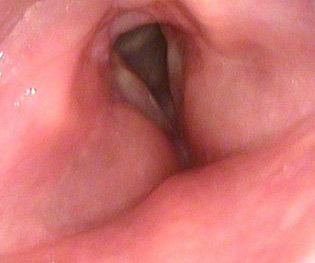Endoscopy of the pharynx and larynx

Endoscopy with the rigid laryngoscope or flexible rhinopharyngoscope has a key role in the modern diagnostic approach of the diseases of the throat and larynx.
Endoscopy with the rigid scope is performed through the mouth, usually without topical anaesthesia. The tongue is gently pulled out of the mouth and the telescope is advanced to the level of the uvula and soft palate. Laryngeal rigid scopes usually have an angle of view of 70 or 90 degrees, so they can «see» downwards , without significant discomfort of the patient.
The flexible scope has usually smaller diameter than the rigid scope. As denoted by its name, it has the ability to bend by means of a knob fitted near the eyepiece, and so it can fit in narrow areas of the nose and throat. It is inserted through one nostril, usually after a mild topical anasthesia, and is advanced to the level of the lower pharynx (hypopharynx). The voicebox and the areas around it, the vocal cords, the trachea and the upper oesophagus can be examined nearly on contact, with the detail and accuracy expected from modern optics.
Both rigid and flexible scopes are usually connected to a camera and the examination is done through a monitor. For technical reasons, the rigid scopes are traditionally known to provide better and larger image than the flexible ones. Nevertheless, modern technology has significantly improve the optics and camera technologies associated with flexible instruments, and today flexible scopes give at least equal, if not better, image than their rigid counterparts.
In our examination rooms, we have available the latest video-endoscope of cutting edge technology, with Xenon illumination and high resolution camera incorporated into the scope, which provides the better image possible at present time.
Examination with the flexible video-endoscope at our office does not require a separate appointment and lasts for a few minutes. A large screen fitted on the wall allows patient and escorts to follow the examination while it is performed. Special preparation by the patient is not required. Due to the topical anaesthetic, which is always applied before the procedure, we advice patients to refrain from eating or drinking for at least an hour after the completion of the examination.